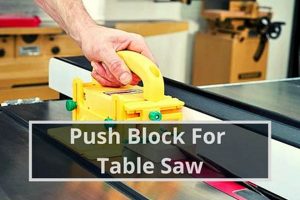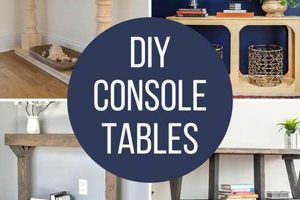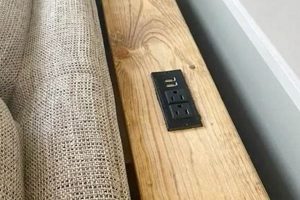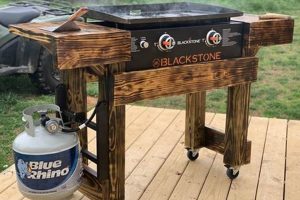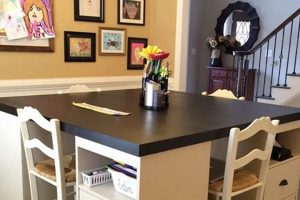A handcrafted recreation of the classic game surface provides an engaging and rewarding project. The undertaking allows for customization in dimensions, materials, and aesthetic details, resulting in a personalized leisure item. For example, individuals might choose specific hardwoods for the playing surface or tailor the overall size to fit available space.
The construction of such a surface can offer numerous advantages. Beyond the inherent entertainment value, it encourages the development of woodworking skills, promotes resourcefulness, and presents an opportunity for collaborative engagement within a household or community. Historically, similar game surfaces have provided avenues for social interaction and friendly competition, contributing to a sense of community and shared enjoyment.
Subsequent sections will explore essential considerations for design and material selection, detail step-by-step construction processes, and address finishing techniques necessary for optimal play and long-term durability. Further discussion will cover maintenance recommendations and potential modifications to enhance the gaming experience.
Essential Considerations for Building a Custom Game Surface
The following guidance is intended to enhance the likelihood of success when undertaking the construction of a personalized sliding puck game.
Tip 1: Material Selection is Critical: The choice of wood for the playing surface directly impacts playability and longevity. Hard maple is frequently cited as an ideal material due to its density and smooth grain, but alternative hardwoods may be suitable depending on budget and desired aesthetic.
Tip 2: Ensure a Perfectly Level Surface: Precise leveling is paramount. Minor deviations can significantly affect puck glide and fairness of play. A precision level and meticulous shimming during construction are essential.
Tip 3: Prioritize a Durable Finish: The finish applied to the surface must be resilient to abrasion and provide a consistent glide. Multiple coats of a catalyzed varnish or epoxy resin are typically recommended for optimal performance and protection.
Tip 4: Implement Proper Jointing Techniques: The method used to join the surface boards is vital for stability and flatness. Tongue-and-groove or mortise-and-tenon joints, properly executed, will minimize warping and shifting over time.
Tip 5: Account for Environmental Factors: Wood expands and contracts with changes in humidity. Leave appropriate expansion gaps around the perimeter of the playing surface to prevent buckling or cracking.
Tip 6: Precision in Dimensions Matters: Adhere strictly to established dimensional standards for the court layout. Accurate measurements are essential for ensuring fair and consistent gameplay.
Tip 7: Consider the Base Construction: The base must be robust and stable to support the weight of the playing surface and withstand regular use. A well-engineered frame constructed from sturdy lumber is crucial.
Adherence to these principles will significantly improve the quality and playability of a self-made recreation of the classic game, enhancing the experience for all participants.
The subsequent sections will delve into specific techniques and advanced considerations to further optimize the construction process.
1. Surface Flatness
Surface flatness is a paramount concern in the creation of a self-constructed sliding puck game. Any deviation from a perfectly planar surface introduces unintended bias and compromises the integrity of gameplay.
- Impact on Puck Trajectory
A non-planar surface introduces inconsistencies in puck trajectory. Even minute variations in height can cause a puck to veer unexpectedly, rendering strategic shots unreliable and undermining the intended skill-based nature of the game. The effect is amplified over longer distances.
- Consequences of Warping or Bowing
Warping or bowing in the wooden playing surface results in an uneven distribution of force as the puck travels. This creates zones where the puck may slow down, speed up, or change direction unpredictably. The consequence is a diminished playing experience and a perceived lack of fairness.
- Challenges in Achieving Perfect Planarity
Achieving a perfectly flat surface requires meticulous woodworking techniques. The use of precision tools, such as a jointer and planer, is essential for creating boards that are straight and true. Even after assembly, the surface may require further flattening through sanding or scraping to eliminate any remaining imperfections.
- Influence on Finish Application
Surface imperfections are accentuated by the application of a finish. Dips and bumps will become more pronounced as the finish settles unevenly. A perfectly flat surface is essential for achieving a smooth, uniform finish that contributes to optimal puck glide.
The pursuit of surface flatness in the construction of a game surface is not merely an aesthetic consideration; it is a fundamental requirement for ensuring a fair and enjoyable playing experience. Achieving and maintaining this planarity demands precision, skill, and a commitment to quality craftsmanship.
2. Wood Selection
Wood selection represents a pivotal decision point in the creation of a self-constructed sliding puck game. The material properties of the chosen wood directly influence the playing surface’s durability, stability, and performance characteristics, thereby impacting the overall gaming experience.
- Hardness and Density
Hardwoods, such as maple and birch, are frequently recommended due to their inherent hardness and density. These properties contribute to the surface’s resistance to wear and tear from repeated puck impacts. Softer woods are more susceptible to denting and scratching, potentially compromising the surface’s smoothness and impacting puck glide. For example, hard maple is often preferred in professional-grade tables, while a more economical choice might be birch. The selection must balance durability with budgetary constraints.
- Grain Pattern and Stability
A tight, straight grain pattern contributes to the wood’s dimensional stability, minimizing the likelihood of warping or twisting over time. Wood with irregular grain is more prone to movement, potentially disrupting the surface’s flatness and affecting puck trajectory. Quarter-sawn lumber, characterized by vertical grain orientation, is often favored for its superior stability. In contrast, plain-sawn lumber, with its tangential grain, is more susceptible to cupping and warping.
- Surface Finish Compatibility
The chosen wood species must readily accept and retain the desired finish. Some woods, such as oak, possess open pores that require filling prior to finish application to achieve a smooth, uniform surface. Others, like maple, have a closed-grain structure and require less preparation. The compatibility of the wood with the intended finish is crucial for achieving optimal puck glide and protecting the surface from moisture and wear. For instance, a film-forming finish like catalyzed varnish adheres better to some wood types than others, depending on porosity.
- Cost and Availability
The cost and availability of different wood species are practical considerations. Exotic hardwoods, while potentially possessing superior properties, may be prohibitively expensive and difficult to source. More common and readily available hardwoods, such as maple and birch, offer a viable alternative. Balancing performance requirements with budgetary limitations and accessibility is essential for making a practical and informed wood selection.
The strategic selection of wood for a self-constructed game directly influences the quality and longevity of the final product. A careful evaluation of hardness, stability, finish compatibility, and cost considerations is essential for creating a playing surface that provides years of enjoyment.
3. Finish Application
The process of applying a finish to a self-constructed sliding puck game surface is not merely an aesthetic consideration; it is a crucial step that directly affects playability, durability, and long-term maintenance. The finish creates a low-friction surface, enabling smooth puck glide, and provides a protective barrier against moisture, abrasion, and impacts. Improper finish selection or application can lead to a surface that is too sticky, uneven, or susceptible to damage, significantly diminishing the gaming experience. For example, using a water-based polyurethane without proper sanding and multiple coats may result in a surface that lacks adequate glide and is prone to scratching.
The selection of the appropriate finish is contingent upon factors such as the type of wood used, the desired level of gloss, and the anticipated frequency of use. Catalyzed varnishes and epoxy resins are often favored for their exceptional durability and resistance to wear. However, these finishes require specialized application techniques and equipment. Alternative options, such as polyurethane, are more user-friendly but may not provide the same level of protection. Proper surface preparation, including thorough sanding and cleaning, is essential for ensuring proper adhesion and a smooth, even finish. For instance, neglecting to remove dust particles before applying the finish can result in a textured surface that impedes puck glide. The number of coats applied also affects the final result; multiple thin coats are generally preferable to a single thick coat, as they minimize the risk of runs and sags.
In summary, the finish application is an integral component in the overall construction of a surface. Careful attention to finish selection, surface preparation, and application technique is critical for creating a durable, playable, and aesthetically pleasing surface. Challenges in this stage often stem from a lack of experience or insufficient understanding of the materials and methods involved. Addressing these challenges through research, practice, and consultation with experienced woodworkers can significantly improve the outcome of the project.
4. Frame Stability
Frame stability is a critical element in the successful construction of a self-made sliding puck game. The frame serves as the foundational support for the playing surface, and its structural integrity directly influences the surface’s flatness, levelness, and overall performance. A poorly constructed or unstable frame can lead to warping, sagging, and uneven play, significantly detracting from the gaming experience.
- Load-Bearing Capacity
The frame must possess adequate load-bearing capacity to support the weight of the playing surface, which can be substantial, particularly if hardwoods are used. Insufficient support can result in deflection or collapse of the frame, leading to an uneven or unusable playing surface. For instance, a frame constructed from undersized lumber or with inadequate bracing may be unable to withstand the constant weight of a thick maple playing surface. Proper engineering principles, including calculations of load distribution and material strength, are essential for ensuring sufficient support.
- Resistance to Warping and Twisting
The frame should be designed and constructed to resist warping and twisting, which can occur due to changes in humidity or uneven stress distribution. Warping or twisting of the frame will inevitably translate to corresponding distortions in the playing surface, affecting puck trajectory and compromising fair play. The use of kiln-dried lumber, proper jointing techniques, and diagonal bracing can significantly enhance the frame’s resistance to these forces. Mitered corners, if not reinforced, are particularly susceptible to failure.
- Dimensional Stability
The frame’s dimensional stability is crucial for maintaining the playing surface’s alignment and levelness over time. Changes in the frame’s dimensions due to expansion or contraction can cause the surface to shift or become unlevel, impacting gameplay. The use of stable materials, such as plywood or engineered lumber, and the implementation of expansion joints can mitigate these effects. For example, allowing for slight movement between the frame and the playing surface prevents stress buildup and minimizes the risk of distortion.
- Vibration Dampening
The frame design can contribute to vibration dampening, minimizing the transmission of vibrations that can disrupt puck movement. A rigid, well-dampened frame will provide a more stable and predictable playing surface. Incorporating rubber feet or other vibration-absorbing materials into the frame’s design can further enhance its dampening capabilities. Such vibration reduction contributes to more accurate and enjoyable game.
In conclusion, frame stability is an indispensable aspect of a successfully built playing surface. It is not simply an afterthought but an integral design consideration that requires meticulous planning, careful material selection, and precise construction techniques. A robust and stable frame provides the foundation for a high-quality, durable, and enjoyable playing surface.
5. Dimension Accuracy
Dimension accuracy is inextricably linked to the successful creation of a recreational game surface. Deviations from established dimensional standards directly impact gameplay, fairness, and the overall enjoyment derived from the activity. A surface that fails to adhere to specified lengths, widths, and surface angles introduces inconsistencies, creating an unfair playing field where skill is diminished and chance amplified. For example, if the length of the court is shorter than regulation on one side, players shooting from that end will have a disadvantage, altering the intended balance of the sport.
The practical significance of dimension accuracy extends beyond mere gameplay. Accurate measurements are crucial for ensuring that the constructed surface fits within the intended space. Miscalculations can result in a structure that is too large or too small, rendering it unusable or requiring costly modifications. Furthermore, adherence to standardized dimensions facilitates compatibility with existing accessories, such as pucks and scoring devices. A surface built to non-standard dimensions may necessitate the creation of custom-sized equipment, adding to the overall expense and complexity of the project. As an example, purchasing standard-sized pucks will not be useful if the surface length is too short to gain momentum.
In conclusion, dimensional precision is not merely a desirable attribute but an essential prerequisite for a functional and enjoyable game surface. Overcoming the challenges associated with achieving accurate measurements requires meticulous planning, precise cutting techniques, and a commitment to quality craftsmanship. The consequence of neglecting this crucial aspect is a surface that fails to meet expectations and detracts from the intended recreational experience. The implications are significant, as it links directly to playability and fairness for all players.
6. Puck Glide
Achieving optimal puck glide on a self-constructed sliding puck surface represents a crucial determinant of gameplay quality. The degree of friction between the puck and the playing surface directly influences the distance, speed, and accuracy of shots. Insufficient glide restricts the puck’s travel, hindering strategic play and diminishing the challenge. Excessive friction requires undue force to propel the puck, leading to fatigue and inconsistent results. Therefore, the pursuit of an ideal glide characteristic is paramount in surface construction. Considerations include material selection, finish application, and ongoing maintenance protocols. For instance, a surface constructed from lower-quality wood with an uneven varnish finish will inhibit puck travel, compared to a meticulously sanded hard maple surface treated with multiple coats of a specialized polymer.
Factors impacting puck glide extend beyond the initial construction phase. Environmental conditions, such as humidity and temperature fluctuations, can alter the surface properties and affect glide performance. Regular cleaning and maintenance are essential to remove dust, debris, and other contaminants that can increase friction. The type of puck used also plays a role; materials, weight, and surface texture can influence how the puck interacts with the playing surface. The selection of pucks should, therefore, be considered in conjunction with the characteristics of the finished surface to optimize glide. Polishing the surface can enhance glide, though the frequency should be evaluated to avoid damage.
In summary, achieving and maintaining optimal puck glide on a homemade sliding puck surface is a complex and multifaceted undertaking. It requires careful attention to material selection, finish application, environmental control, and ongoing maintenance. The effort invested in optimizing glide translates directly into enhanced gameplay, increased enjoyment, and a more rewarding recreational experience. Conversely, neglecting this crucial aspect compromises the integrity of the game and diminishes the value of the constructed surface. The interplay is evident in the game’s core mechanics and must be addressed during construction and upkeep.
Frequently Asked Questions Regarding DIY Shuffleboard Table Construction
The following addresses common inquiries pertaining to the design, construction, and maintenance of self-made sliding puck game surfaces. The information is intended to provide clarity and guidance for individuals undertaking such projects.
Question 1: What is the minimum recommended length for a playing surface?
While smaller surfaces are possible, a minimum length of 12 feet is generally recommended to allow for a reasonable range of play. Shorter surfaces may restrict strategic shot selection and diminish the overall gaming experience.
Question 2: Is it necessary to use kiln-dried lumber for the playing surface?
Yes, the use of kiln-dried lumber is highly recommended. Kiln-drying reduces the moisture content of the wood, minimizing the risk of warping, twisting, or cracking after construction. This contributes to the long-term stability and flatness of the playing surface.
Question 3: What type of finish provides the best puck glide?
Catalyzed varnishes and epoxy resins are generally considered to provide the best puck glide due to their exceptional hardness, durability, and low coefficient of friction. Multiple coats are typically required to achieve a smooth, even surface.
Question 4: How can I ensure that the playing surface is perfectly level?
Achieving a perfectly level surface requires meticulous leveling techniques. A precision level should be used to check the surface in multiple directions. Shims can be used to adjust the height of the frame as needed to achieve a perfectly level plane.
Question 5: What is the best way to clean the playing surface?
The playing surface should be cleaned regularly with a soft, dry cloth to remove dust and debris. Avoid using abrasive cleaners or harsh chemicals, as these can damage the finish and affect puck glide. Specific cleaning solutions designed for use on finished wood surfaces may be employed sparingly.
Question 6: How can I protect the playing surface from damage?
The playing surface should be protected from direct sunlight, extreme temperatures, and excessive humidity. A cover can be used to protect the surface when it is not in use. Care should be taken to avoid dropping heavy objects on the surface, as this can cause dents or scratches.
Adherence to these recommendations will contribute to the longevity and playability of the self-constructed sliding puck game surface. The importance of careful planning and execution cannot be overstated.
The following section addresses potential modifications and customization options for the recreation game surface.
Concluding Remarks on DIY Shuffleboard Table Construction
This exploration of the “diy shuffleboard table” has underscored the critical aspects of design, material selection, and construction techniques necessary for a successful outcome. Achieving optimal playability hinges on adherence to dimensional standards, ensuring surface flatness, and applying appropriate finishing methods. Frame stability and puck glide are of paramount importance, influencing both the longevity and the enjoyment derived from the finished product. A commitment to meticulous craftsmanship is therefore essential.
The construction of a personalized game surface represents a significant undertaking, demanding both skill and patience. The potential rewards, however, extend beyond mere recreation. A well-executed project can yield a durable, aesthetically pleasing addition to the home, fostering social interaction and providing years of enjoyment. Careful consideration of the factors outlined herein will significantly enhance the likelihood of a positive and lasting result.


